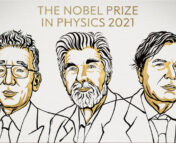Authors: Jessica Hernandez, Rachel Scherr, Molly German, and Rey Horowitz
First Author’s Institution: Division of Physical Sciences, School of Science, Technology, Engineering, and Mathematics, University of Washington Bothell
Status: Published in Sustainability and Climate Change [closed access] (the first author kindly shared the article with us)
What first comes to your mind when you think of “energy”? If you’re a person with a physics or astronomy background, you think of the abstract concept describing physical processes, and might add words like “potential” or “kinetic” to it. However, we use the word “energy” in everyday life as well. There is a number of physical terms that we use in social contexts all the time: “energy,” “efficiency,” “work,” etc., and they affect our lives. For example, when we talk about global temperature rise due to climate change, there’s still the same high-school physics involved, but we often overlook its impact on social issues. Energy, whether you think of it as a physical term or as a social one, plays a role in climate change, despite its abstract nature in physics.
The authors of today’s paper suggest we pay more attention to the social impacts of physics. For example, people of color are negatively impacted by climate change significantly more than others. Yet, physics classrooms often fail to both engage students in discussions about climate change and engage with students of color. The fact that right now physics is taught to a diverse population of students, all of which are in some way affected by socio-political issues suggests that physics education should not be apolitical and acultural. In light of this disconnection between a traditional physics education and students’ lived experiences, today’s authors conducted case studies on place-based physics education, specifically where high-school teachers develop their curriculum to link physics and climate change.
Case #1
Molly German, a teacher at a rural high school in the Sacramento Valley of Northern California, hoped that the locally relevant implications of climate change would spark her students’ sense of belonging. As a reference to environmental issues, she designed a project involving the Oroville Dam, which had flooded in 2017. The students began researching the climate crisis with a simple task: make dirty water. It seems very simple (it is so much simpler to make something dirty than clean, right?), and the students used their imagination using not only the dirt from outside but also incorporating cooking oil, food coloring, coffee grounds, and other household products. The next task was to create water filters. This was trickier, because they had to think about how to remove the dirt that they created! Most groups used easily-accessible things like coffee filters, gravel, or paper towels to try to clean the water. In addition to the above, this task led to discussions about evaporation, condensation, liquid state – the physical concepts that we learn from definitions in our textbooks!
German hoped that these exercises would help them link the physical terms with the global crisis – climate change. To strengthen the applicability of abstract physics into our world, German showed her students a documentary Thirsty for Justice, which highlights different water concerns in California. California is these students’ state, so the documentary was supposed to help them think about their community’s local water issues. After that, the students were tasked to conduct research projects about local water. The topics included Indigenous tribal water rights, death of salmon populations, testing the quality of a local water source, etc. Some students who like to fish decided to investigate mercury contamination of fish from past gold mining operations. These research projects sparked conversations about climate justice and how the hierarchy of power around clean water works. Importantly, this place-based education allowed the students to contextualize physics within their own experiences.
Case #2
Rey Horowitz, who teaches neurodiverse students of color in a New York City school, developed a study of energy topics, trying to understand local energy justice campaigns. Before the course, the students had minimal understanding of the science related to energy and the effects of its uneven distribution. One of their tasks was to prioritize the energy sources among their family, neighborhood, and the country, as if they had the power to actually distribute the energy. The students did consider the efficiency and availability in natural disasters, but more human-centered values tended to be missing from their priorities list. So, Horowitz began encouraging the students to think critically and figure out the impact of energy use on different people.
To connect this goal to the community the students are familiar with, Horowitz referred them to peaker plants. These are electricity-generating substations designed to run only at times of high demand and are mostly located at low-income communities, i.e. predominantly, the communities of color. These power plants also generate air pollution and are expensive to maintain, so there are different organizations that are campaigning to replace them. The students realized that these plants were everywhere they went! One of them even wrote an article explaining the financial, environmental, and health impacts of these peaker plants. This way, Horowitz helped the students recognize the parts they play in the discourse surrounding energy justice and visualize realistic steps they can take to combat the climate crisis.
Lessons learned
Place-based education can actually increase students’ sense of belonging in their community and their awareness about climate justice, especially students of color. These two case studies turned out to be important in contextualizing physics and climate change to the students’ local communities. The students used their creativity and had a chance to improve the environment in which they live, they also engaged in their classroom, and actually got a chance to learn physics! So, maybe it’s time to implement a place-based curriculum to make high school physics education more inclusive, and better connected to community values rather than simply focusing on abstract ideas
This article was written as a part of our Climate Change Series. We’d love to hear what you would like to see from this initiative – if you have ideas, please let us know in this google form.
Astrobite edited by: Olivia Cooper, Pratik Gandhi
Featured image credit: Angela Hsieh/NPR




